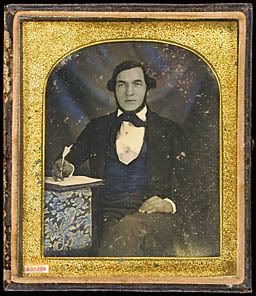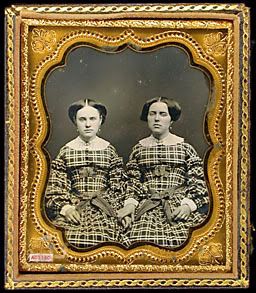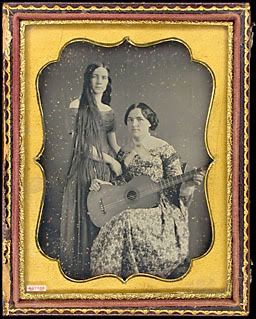1138
Photographs are the closest thing we have to a time machine. Even "realistic" paintings and drawings of earlier times are inevitably influenced by the artist's style, imagination, and technique (which of course is as it should be). Photographs, though, show how people and things actually looked at a given time. (I exempt "art" photography and, naturally, shots that have been digitally manipulated.)Daguerreotypes were one of the very earliest media, invented in 1839, according to the Lazy Person's Quick Reference Handbook, aka Wikipedia, and most date from then to about 1850, when other photographic techniques began to replace them. Daguerreotypes were made by exposing an image on light-sensitive chemicals on a metal plate.
Only one "print" could result, a negative, which however looks positive when viewed at the right angle to the light. Seeing original daguerreotypes (not conventional photographic reproductions of them) is a strange, almost unsettling experience: something about the metal on which the image resides, or maybe the chemicals, gives them an uncanny lifelike appearance, as though you are looking through a hole in space-time to another reality — which is not far from the truth.
Photos from the later 19th century are not that uncommon; we've all seen Matthew Brady's Civil War-era pictures. Part of what I find fascinating about daguerreotypes is that they date from a generation earlier, a time not often seen in photographs.
The Daguerreian Society has an online collection, arranged by category. The pictures of buildings &c are interesting enough, but some of the houses and offices, or similar ones, are still standing. What I am most drawn to are the portraits: people like us, yet living in a physical and social environment so different that most of us have trouble imagining it.
I'm posting a few samples here. They are in Flash format, and I cannot enlarge them when I transfer them here (or if there's a way to, I don't know it). But If you go to the Daguerreian Society site and look them up — I've included their identification numbers — you can zoom in on any part you want to see up close, such as faces. (You click the image and then navigate by clicking the plus and minus signs and arrows.)
Most of the men and women are well dressed — they would be, wouldn't they? When photography was a rarity, it was the well-to-do who had their pictures taken, although they were probably comfortable middle class. The very rich still had their portraits painted, and probably thought getting your features captured by a bizarre new device was déclassé.
Surprisingly, quite a few portraits are of blacks, looking reasonably prosperous. These portraits were almost certainly made in the northern states.
Not many of the women are dressed in formal wear (some of the men are), but their gowns look well tailored and accessorized (nice shawls). Women's jewelry doesn't change much over time. Plenty of jewelry in museums from ancient days could be worn today without attracting particular notice.

206
The women's dress fabrics and patterns are often pleasing, especially if you visualize them in color, but bonnets strike us as goofy. Even the attractive woman above can't pull it off (according to our standards).

1208

1208
The way people wore their hair is another thing that leaps to the modern eye. While the women's hair is styled, ringlets and buns don't do much for their sex appeal. As for the men, well, the very concept of hairstyling didn't exist. I guess the best a bloke could hope for was a competent barber.

1180

1180
There aren't many smiles in these portraits. Partly, that may be because taking a photo wasn't the instantaneous process it is now. The subject had to sit still for a minute or more to let the image register on the plate.
Nevertheless, it's hard to doubt that this was a generation for whom life was a very serious business. They knew they or their loved ones could be taken out of it by illness with little prior notice, and most of them expected they would be judged severely in the afterlife. Yet it was more than that, I think: they believed in reflecting dignity and earnestness to the world. Did that take some of the fun out of their existences? Perhaps. But fun isn't happiness. And happiness isn't everything life is about, which the people in these daguerreotypes may have known better than most of our contemporaries do.
Nevertheless, it's hard to doubt that this was a generation for whom life was a very serious business. They knew they or their loved ones could be taken out of it by illness with little prior notice, and most of them expected they would be judged severely in the afterlife. Yet it was more than that, I think: they believed in reflecting dignity and earnestness to the world. Did that take some of the fun out of their existences? Perhaps. But fun isn't happiness. And happiness isn't everything life is about, which the people in these daguerreotypes may have known better than most of our contemporaries do.




1 comment:
This is a great article and sure to pique people's curiousity; but I do have one clarification.
It's not uncommon to see a statement like the one above "The subject had to sit still for a minute or more to let the image register on the plate."
This is not too far from the truth, but an exposure of 20 to 40 seconds would probably have been more common than an exposure of more than a minute.
The original process required an exposure time of minutes. But the addition of Bromine vapors to the process came early and greatly accelerated the process.
Post a Comment